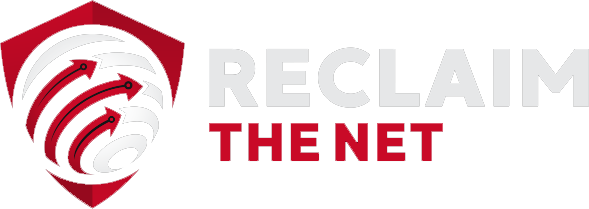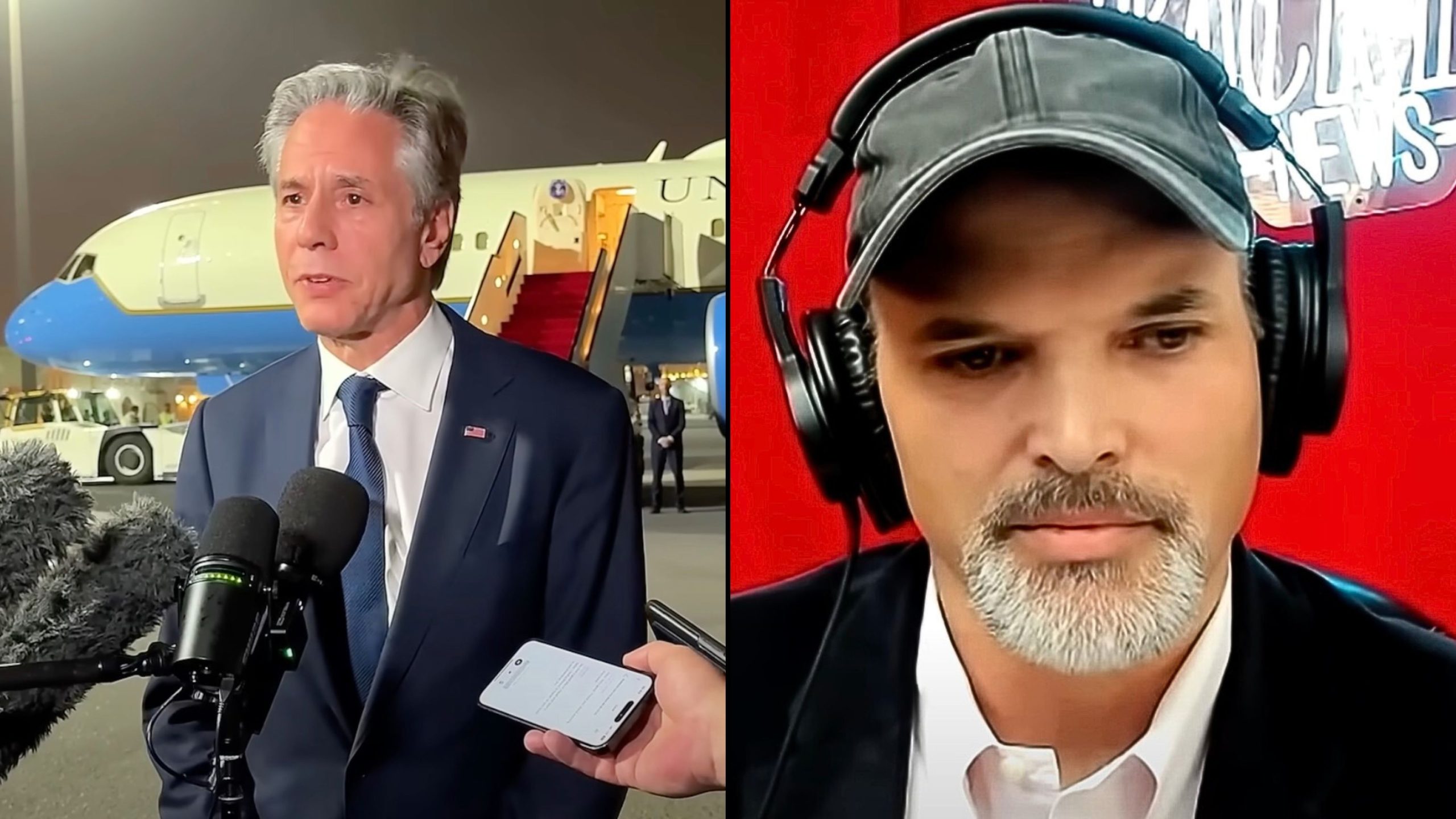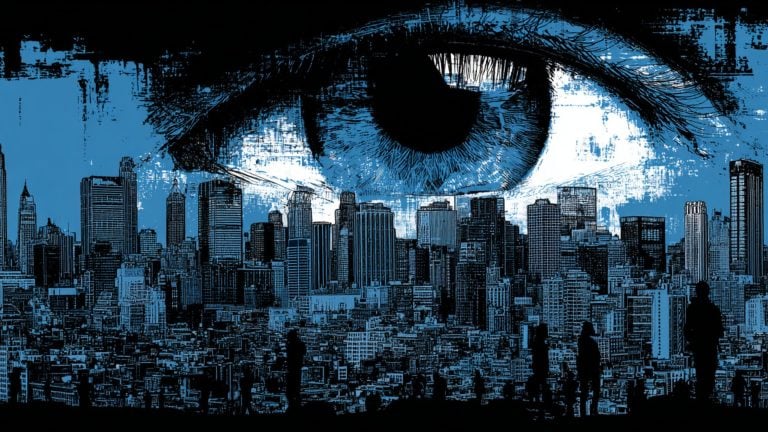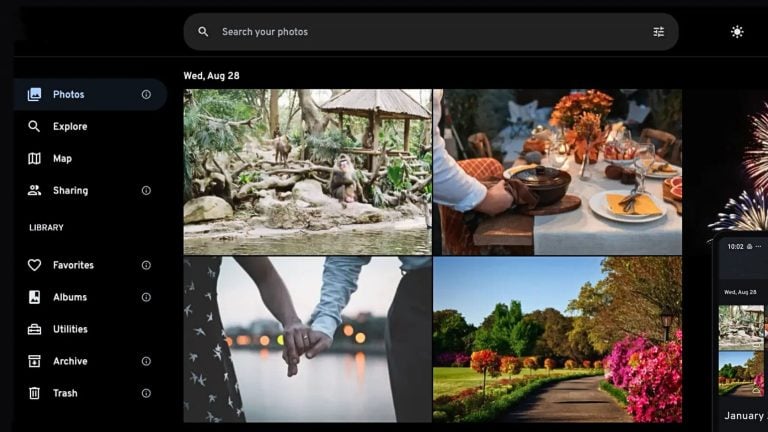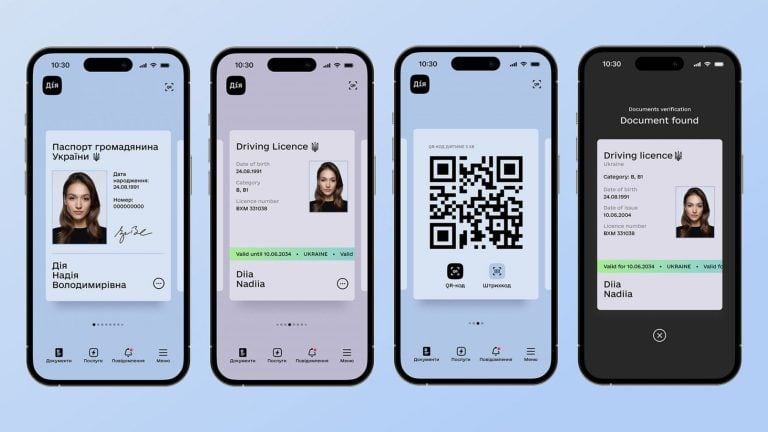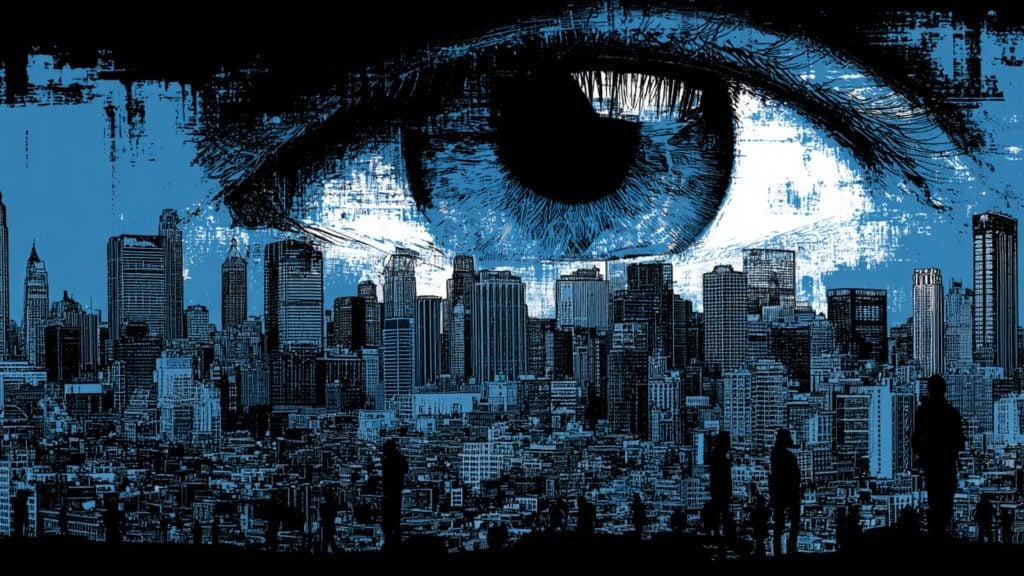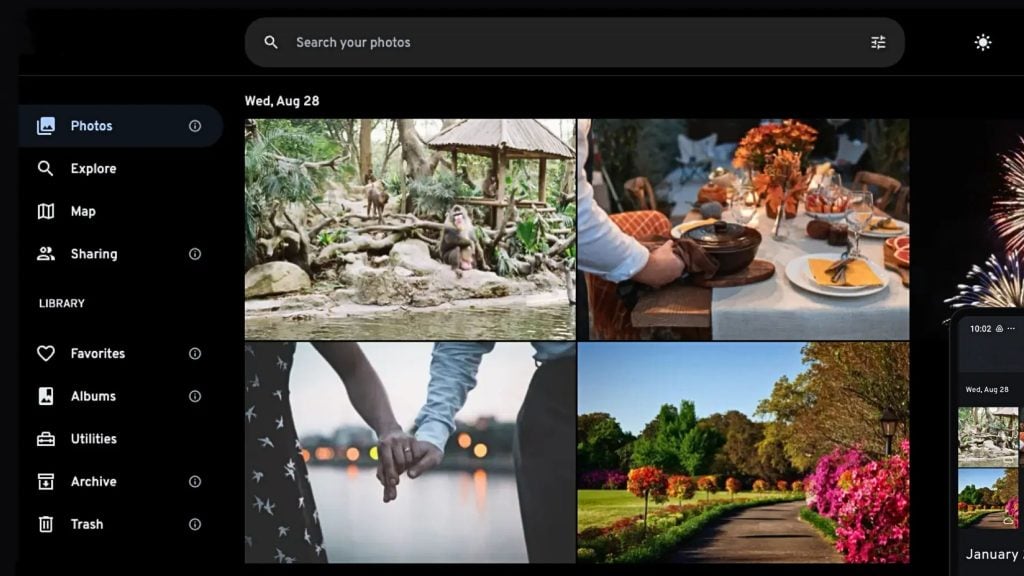The State Department has pulled off yet another PR stunt that’s sure to land it in the annals of “How Not to Handle Scandal.” Faced with the inconvenient truth that they had their fingers in the cookie jar – namely, funding a “blacklist” that included mainstream media outlets like The New York Post, Fox News, The Daily Wire, and Breitbart News – the geniuses over at Foggy Bottom decided the best course of action was to discredit the very journalists exposing their little operation.
Matt Taibbi, one of the masterminds behind the “Twitter Files” revelations, and Gabe Kaminsky, an investigative reporter at the Washington Examiner, have been painting a very uncomfortable picture for the team at the State Department.
The Accusation: “Misinformation”
So what’s the response when two reputable reporters pull back the curtain on what looks suspiciously like a control mechanism for media narratives? Simple: You accuse them of spreading “misinformation.”
Because apparently, it’s 2024, and the word “misinformation” now means, “We don’t like what you’re saying, so here’s a label to make you go away.”
The New York Post, which was part of this blacklist, managed to secure internal documentation that shows just how far the State Department went to salvage the crumbling credibility of its already-controversial Global Engagement Center (GEC).
The GEC, for those keeping score, is the same department tasked with combating foreign disinformation, though it seems their scope has expanded to include anyone reporting on stories they’d rather not talk about.
Taibbi, as usual, didn’t pull any punches. His Twitter Files series, based on internal Twitter documents, showcased how social media platforms were being cajoled and manipulated by government forces to suppress or promote specific narratives. Not content with just annoying one powerful institution, Taibbi went after the State Department’s GEC, shining a spotlight on the shady financial dealings between the government and third-party organizations compiling “blacklists” of media outlets guilty of wrongthink.
Of course, none of this would have been necessary if the GEC had kept its head down. But bureaucrats, as is their wont, tend to panic when someone shines a flashlight on their dirty laundry. Enter stage left: the press guidelines. In March 2023, the State Department rolled out a slick new set of talking points, no doubt cooked up in the most dimly lit corners of their PR department, aimed at spinning the story into something—anything—other than what it was: a damning revelation of the government’s not-so-subtle influence over free speech.
Press Guidelines to the Rescue
Instead of addressing the substance of the allegations—that the government was essentially bankrolling censorship—the State Department decided to do what it does best: pretend the critics are the problem. With all the grace of a bad high school debate team, they put their press people on the case, hoping to quash the fire Taibbi and Kaminsky had lit under them.
The timing, of course, is impeccable. Just as public trust in the government’s overreach into media and social media is hitting rock bottom, and the Twitter Files revelations are still making waves, the State Department thinks it can throw out the word “misinformation” and watch the problem disappear.
But here’s where it gets laughable: everyone they tried to smear was doing exactly what journalists and elected officials are supposed to do—hold the government accountable. That congressional member they targeted? Just another pesky representative of the people trying to do their job, asking why taxpayer dollars were being used to fund lists that could be construed as tools for censorship.
Picture this: it’s early 2020, the world is grappling with lockdowns and mandates, and while everyone is figuring out how to make sourdough bread, a handful of journalists and scientists are asking uncomfortable questions. And who comes charging in on a white horse? The GEC—the State Department’s very own “disinformation” police—along with a legion of government agencies, all determined to keep certain theories from spreading faster than the virus itself.
But, as Matt Taibbi has unflinchingly revealed, their so-called noble intentions might have had less to do with protecting public health and more to do with controlling the narrative. It turns out that when the powers that be decide they don’t like what you’re saying, they can flex their muscles and get social media companies to do their dirty work. And that’s exactly what they did.
Thanks to Taibbi’s relentless social media sleuthing, the GEC’s shadowy activities were exposed for the world to see. During the early days of COVID-19, when uncertainty was at an all-time high, the GEC didn’t just sit on the sidelines—they actively pressured US social media giants to suppress certain discussions, especially around the origins of the virus. The term “disinformation” became a catch-all excuse to silence anyone daring to deviate from the official script.
This wasn’t just some ad-hoc operation, either. In March of the same year, Taibbi went before Congress to lay out the full extent of this coordinated effort. Turns out, there was an entire formal protocol in place among major tech companies and almost every government department that has an acronym—FBI, DHS, HHS, DOD, and yes, our old friend the GEC. Even the CIA wanted in on the action. These agencies, in the name of public safety, were sending moderation requests—essentially a government-sanctioned “please delete this” letter—to the tech overlords, asking them to flag, suppress, or outright remove posts and people who dared challenge the mainstream narrative.
Remember the early days when the mere mention of COVID-19 escaping from a Wuhan lab was met with eye rolls and accusations of racism? If you even hinted at the possibility, you risked being branded a conspiracy theorist on par with someone who thinks Elvis is still alive. But behind the scenes, there were some pretty respectable virologists and scientists who weren’t so quick to dismiss the idea.
These distinguished experts maintained that the evidence was, at the very least, inconclusive—and that there was more reason to believe the virus may have leaked from a lab than jumped from a bat to a pangolin to a human in some implausible wildlife game of telephone. Yet, this theory was deemed too dangerous for public consumption. After all, what would people think if they started asking questions about government-funded research in Chinese labs?
So why the full-court press to shut down any discussion about the lab leak theory? Well, if COVID-19 did originate in a lab, it would be a catastrophic indictment of government oversight and accountability—not just in China, but right here in the good ol’ U.S. of A., where public funds were being funneled to research institutes like the infamous Wuhan Institute of Virology. It’s a narrative too hot to handle for the bureaucratic elite who’d rather the public just stick to the sanitized version of events: the virus came from a wet market, no one’s at fault, and you should stop asking questions.
Flagging those who talked about the lab leak theory wasn’t just a precautionary measure—it was an act of self-preservation. Governments didn’t want fingers pointing in uncomfortable directions, particularly at the glaring conflicts of interest between US-backed gain-of-function research and the origins of the pandemic. So they went for the next best thing: shut people up.
And tech companies? They were more than happy to oblige. Taibbi’s revelations made it clear that Twitter, Facebook, and Google weren’t just passive platforms—they were active participants in a system designed to control what you could and couldn’t say. When the GEC or any other government body came calling, the social media giants rolled over like well-trained puppies. Need us to flag a post? Sure thing. Want us to shadow-ban a user? Consider it done. Anything to avoid the wrath of regulators or the bad PR that comes with being accused of “enabling disinformation.”
Of course, now that the lab leak theory has gained more traction—thanks to ongoing investigations and the fact that it’s no longer politically expedient to deny its plausibility—the initial wave of censorship looks even more suspect.
Following The Money
Kaminsky, a rising star in journalism with a knack for turning over rocks to find what’s festering underneath, uncovered a rather curious $100,000 grant from the GEC to a London-based organization called the Global Disinformation Index (GDI). The GDI, in its self-congratulatory fashion, bills itself as the world’s first evaluator of media outlets based on their likelihood to spread disinformation. But instead of focusing on, say, foreign propaganda or misinformation campaigns from adversarial states, GDI decided to point its finely tuned censorship machine at a list of conservative and libertarian media outlets. Convenient, right?
Despite the GEC’s explicit mandate to keep its activities confined to the international stage, somehow this grant ended up financing a blacklist of US media organizations. In a move that would make any self-respecting autocrat blush, GDI compiled a list of ten media outlets it deemed especially prone to disinformation, all of which lean right or libertarian in their content. Among the victims? The New York Post, which was crowned the most susceptible paper in the US to disinformation. Yes, the same New York Post that’s been around since 1801 and broke the infamous Hunter Biden laptop story that the establishment tried to bury faster than a bad Yelp review.
GDI, armed with taxpayer money funneled through the GEC, didn’t just want these outlets flagged—they wanted them financially sidelined. They worked with advertising associations, the kind that decide where companies spend their marketing dollars, to ensure these conservative outlets were deemed too risky to advertise with. Because, as we all know, nothing screams “free speech” like covertly cutting off someone’s funding.
Kaminsky didn’t stop at the initial $100,000 grant either. He followed the money trail and found that the GEC had also forked over an additional $545,000 via a government-backed grant from the National Endowment for Democracy. Apparently, disinformation-fighting isn’t cheap. But interestingly enough, those grants were not renewed. Perhaps even the bureaucratic overlords realized that spending over half a million dollars on a British outfit to blacklist American media outlets was a bit much. Or maybe they just thought the operation was too obvious and clumsy.
Still, the GEC didn’t exactly learn its lesson. Other grants were funneled to groups like the Digital Forensic Research Lab, a brainchild of the Atlantic Council. Their job? Flag comments on social media that didn’t align with the government’s version of events. You know, because nothing says “engagement” like hiring outside groups to monitor and suppress speech on Twitter and Facebook.
By the time Kaminsky’s revelations hit, you’d think the State Department might offer some kind of apology or at least an explanation for why public money was being used to blacklist U.S. media outlets. But instead, they opted for the classic Washington move: deflect and blame the whistleblowers. The State Department’s secret documents, obtained by The New York Post, showed zero remorse for this taxpayer-funded fiasco. Rather than address the fact that they’d essentially subsidized a censorship operation, they tried to pin the blame on the usual suspects: Matt Taibbi, Gabe Kaminsky, and—because why not?—Elon Musk.
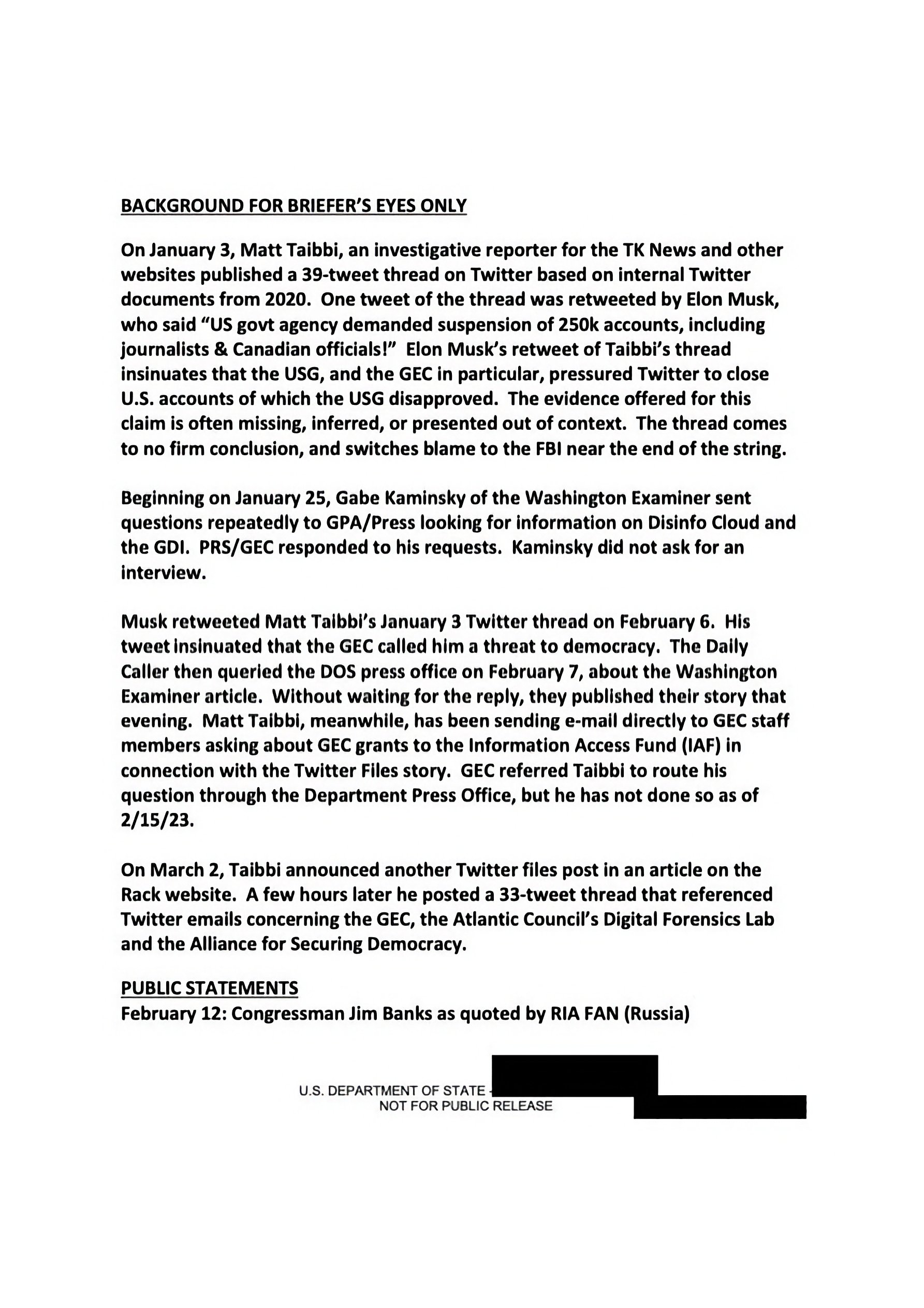
“Elon Musk’s retweet of Taibbi’s thread insinuates that the [US government], and the GEC in particular, pressured Twitter to close U.S. accounts of which the [US government] disapproved,” the document reads. “The evidence offered for this claim is often missing, inferred, or presented out of context. The thread comes to no firm conclusion, and switches blame to the FBI near the end of the string.”
Even pro-censorship Yoel Roth, the former head of Trust and Safety at Twitter (a title that should make anyone familiar with Orwell wince), expressed his unease with the GEC. Roth noted that Twitter’s partnership with the GEC became uncomfortable after discovering the agency’s involvement in sketchy “influence” operations. You know it’s bad when a guy whose job was to police speech on a platform known for suppressing stories says the GEC went too far.
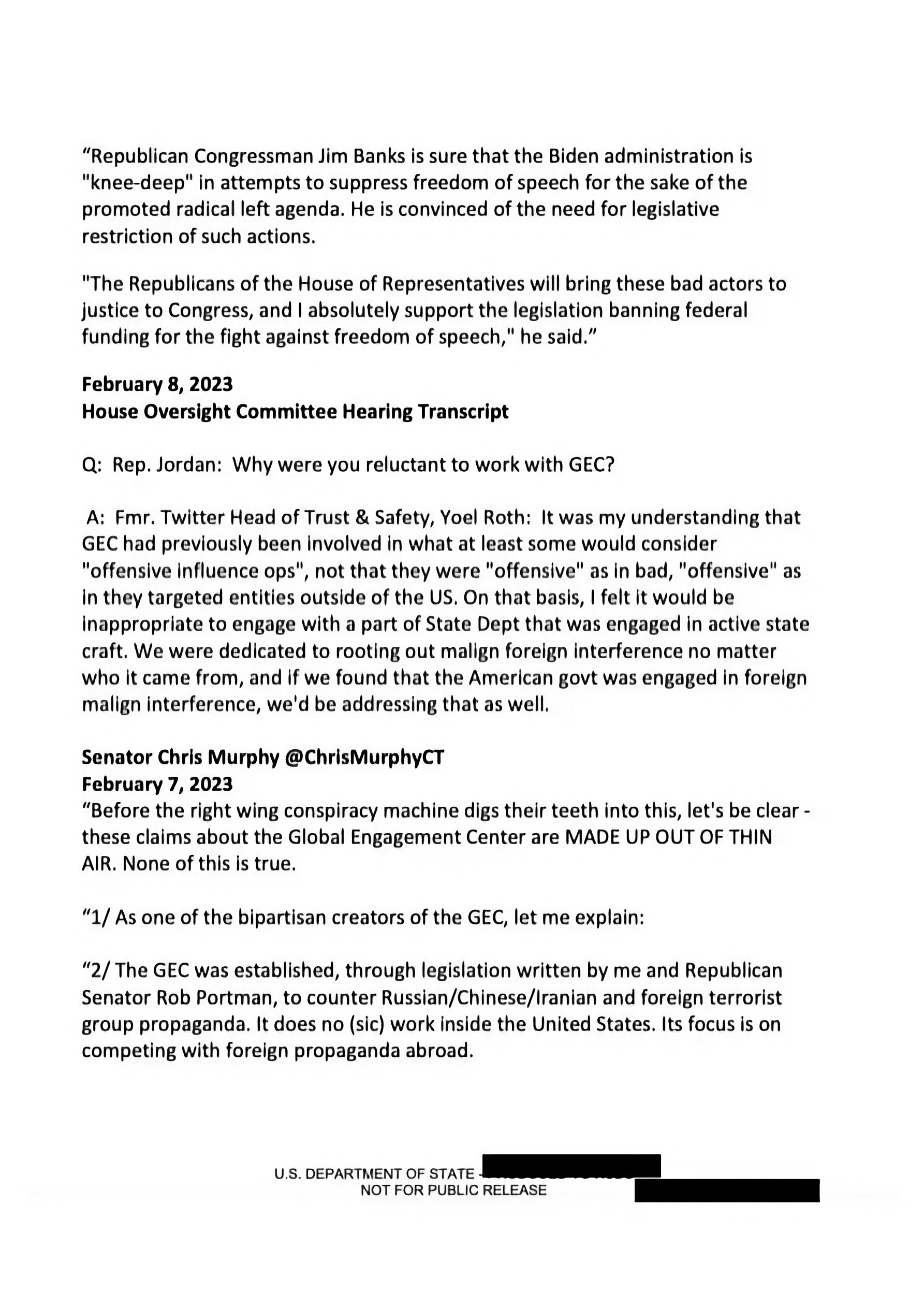
And what about Kaminsky’s efforts to get the State Department’s side of the story? Well, in a show of peak bureaucratic arrogance, the GEC’s only real response to Kaminsky’s damning report was to complain that he hadn’t sought an interview. Never mind that Kaminsky had, in fact, repeatedly tried to get answers from the State Department’s press office, only to be stonewalled. This, of course, is a classic tactic: when you don’t have a good defense, just claim the journalist didn’t ask the right questions—or worse, didn’t ask at all.
Rep. Jim Banks (R-Ind.) and Sen. Chris Murphy (D-Conn.) represent two sides of the coin on the GEC’s funding and mission. Banks, in what should have been a straightforward defense of free speech, called out the GEC for its shady practices in moderating domestic content. Murphy, meanwhile, took to Twitter to downplay the explosive reports by Kaminsky and Taibbi, conveniently claiming they were full of hot air. The State Department, faced with these two competing views, did what any bureaucracy would do: they quoted Murphy’s Twitter thread while throwing shade at Banks.
Murphy’s thread essentially boiled down to a modern bureaucratic classic: “Nothing to see here, folks!” He tried to dismantle the revelations by Kaminsky and Taibbi, arguing that these bombshell reports just didn’t hold water. The fact that his tweets were given pride of place in internal State Department memos isn’t surprising; when you’ve got a narrative to control, why not highlight the guy on your side?
But here’s where it gets almost too ridiculous: the press officers were specifically instructed to say that the GEC has never attempted to moderate content on social media. That’s right, the same GEC whose fingerprints have been all over requests to flag and suppress “disinformation” is apparently now claiming it’s just an innocent bystander, never involved in telling social media platforms what to do. The State Department would have you believe that all those revelations about cozy relationships between Big Tech and government agencies? Just a series of unfortunate misunderstandings. Pay no attention to the man behind the curtain.
What’s worse, the State Department couldn’t resist playing the age-old game of guilt by association. By subtly connecting Rep. Banks’ pro-First Amendment stance with Russian influence operations—because clearly, anyone standing up for free speech in today’s America must be on the Kremlin’s payroll—the State Department attempted to undermine the entire Washington Examiner exposé. This wasn’t just about defending the GEC; it was about smearing the credibility of anyone raising legitimate concerns. The message was clear: you’re either with the GEC or you’re with the Russians.
Of course, this sleight-of-hand tactic wasn’t aimed at making any real argument. It’s the kind of maneuver that gets thrown into the conversation when you don’t have much else to go on. Can’t address the actual claims? No problem—just suggest your opponent is unknowingly helping Russia, and watch as the conversation shifts from “Is the GEC overstepping?” to “Is Jim Banks a secret Putin puppet?”
According to their own internal documents, the State Department has responded to multiple reporters’ inquiries, and they’ve always been cooperative with legislative oversight. Sure, they’ve been “responsive”—in the same way a politician answers tough policy questions by talking about their humble childhood. In reality, their answers have been more evasive than informative, leaving Kaminsky and other journalists with little more than stonewalling.
